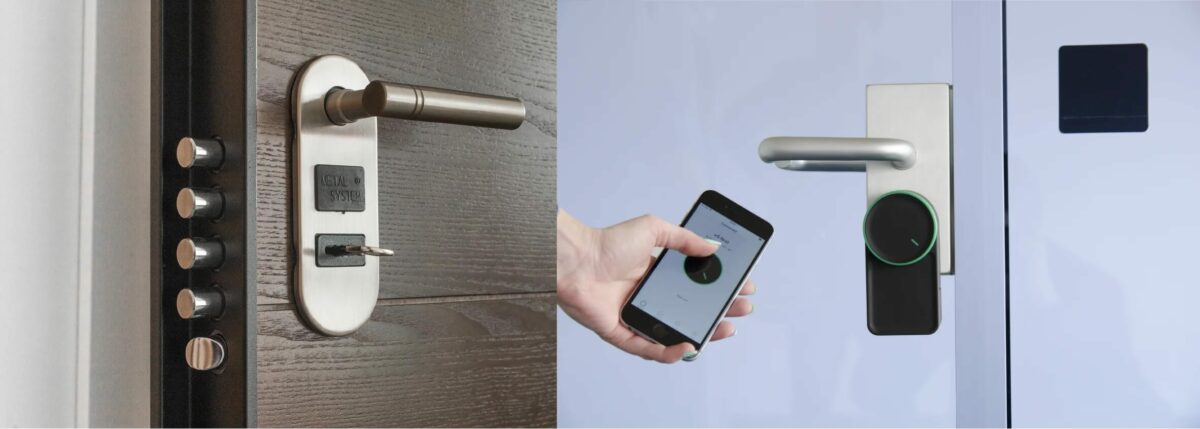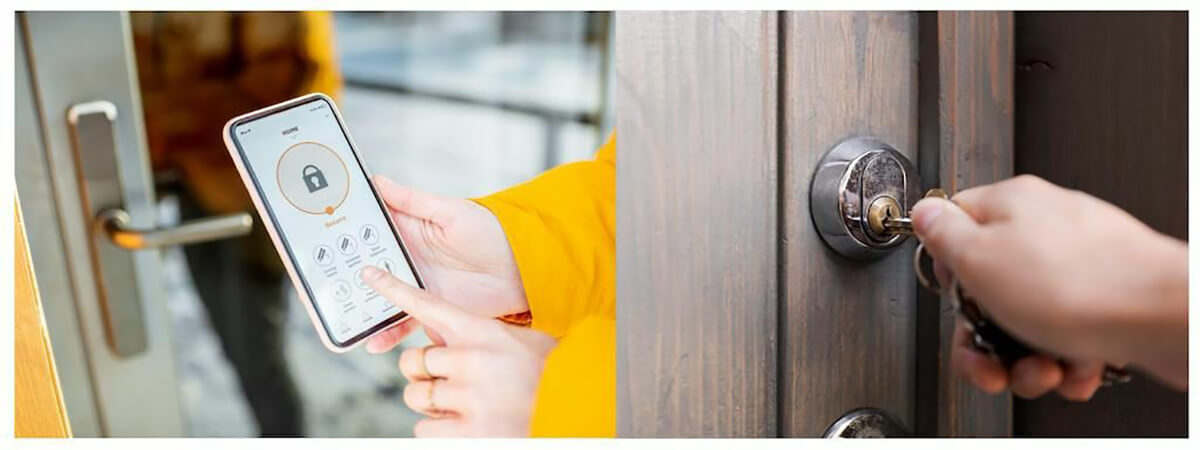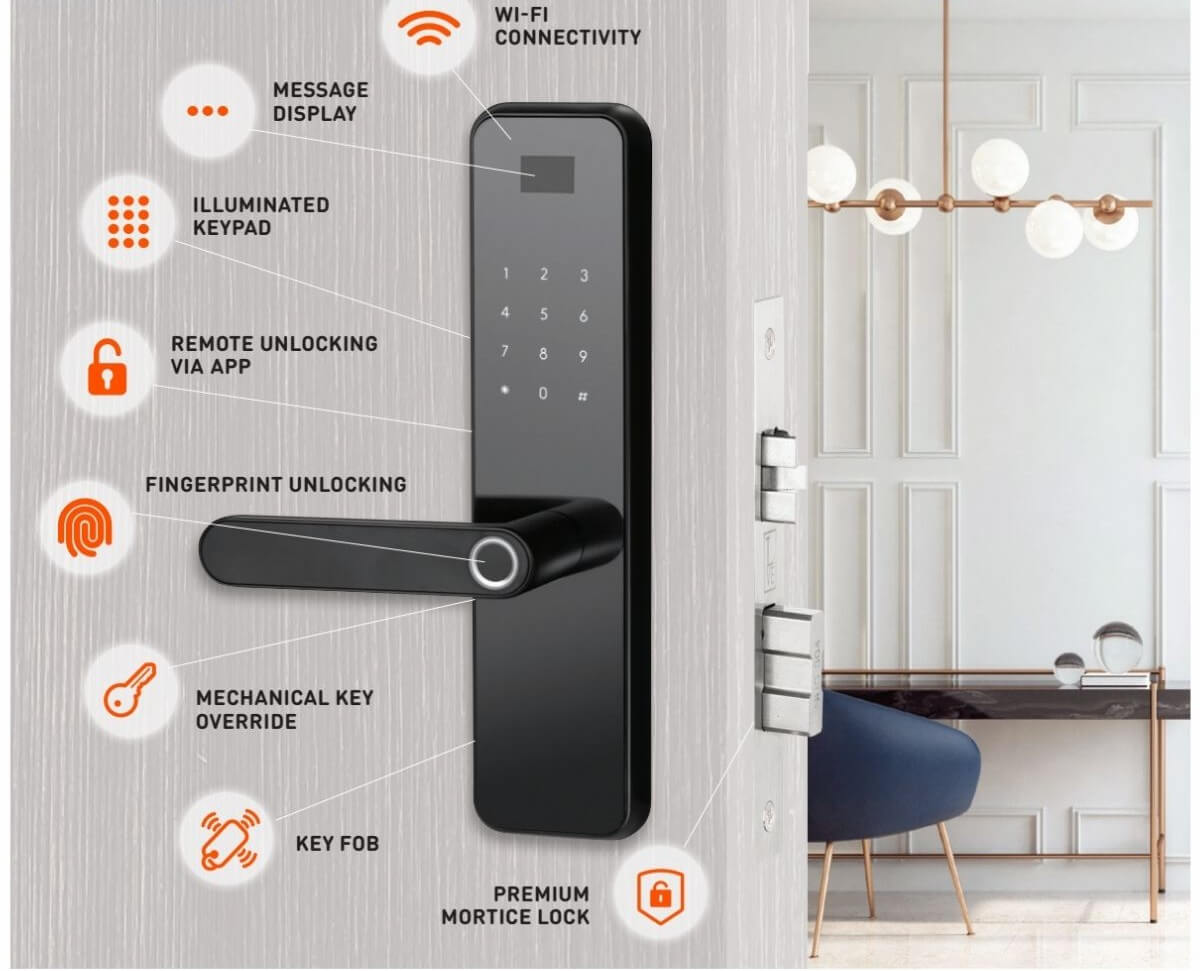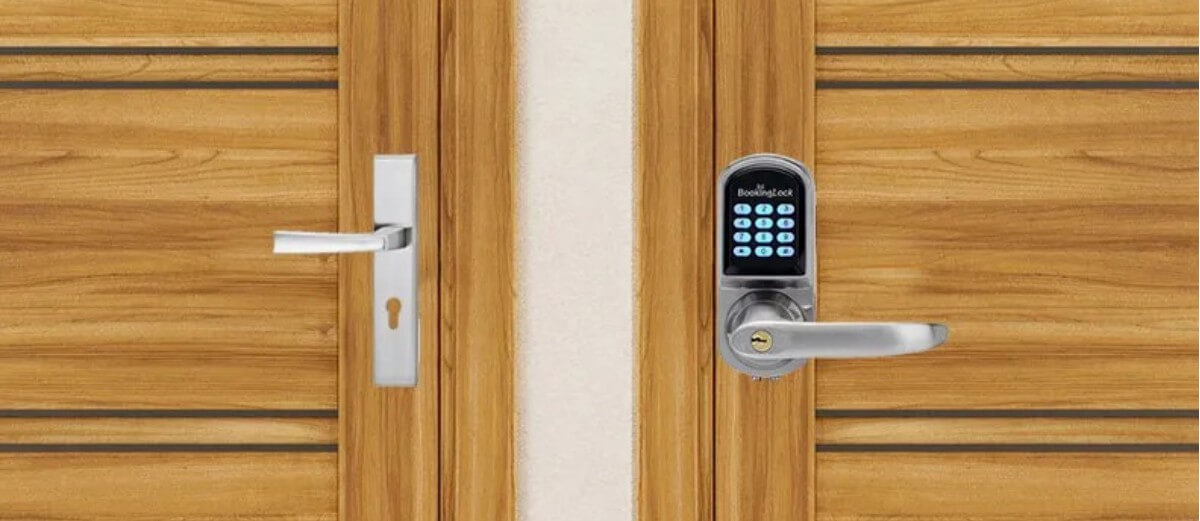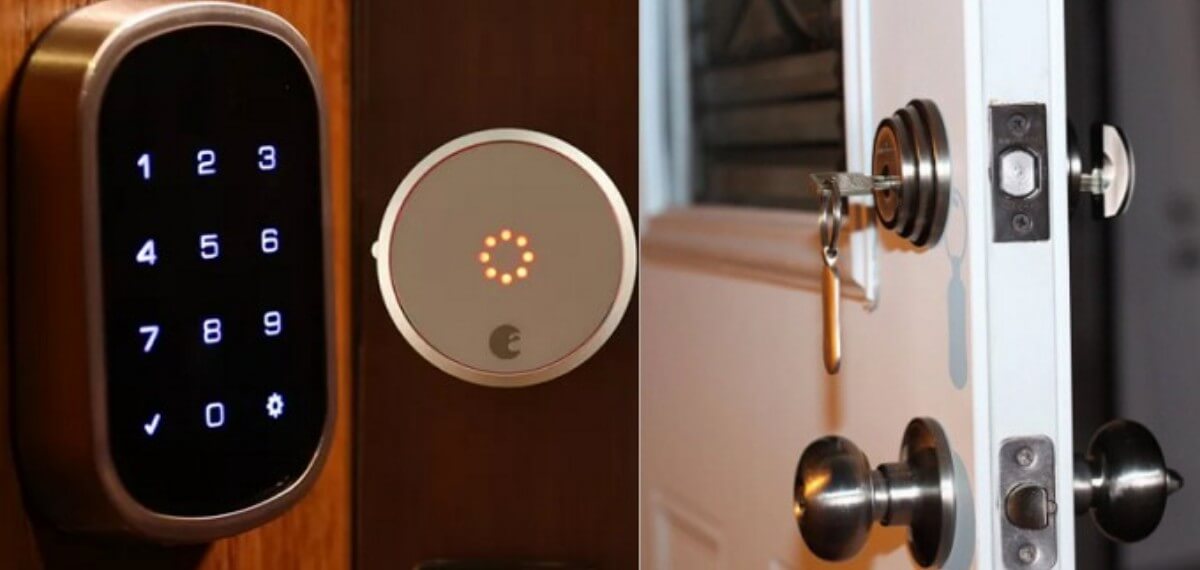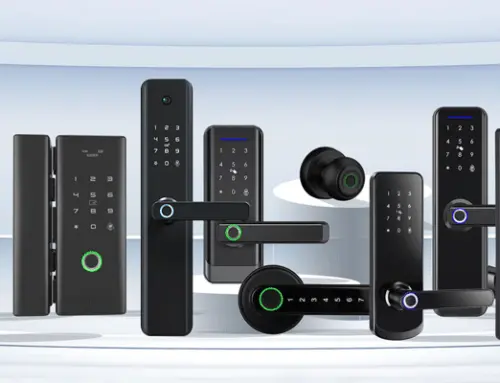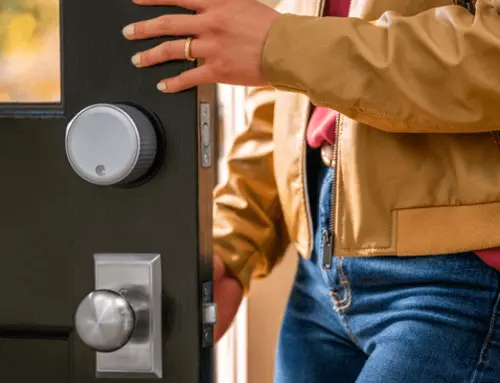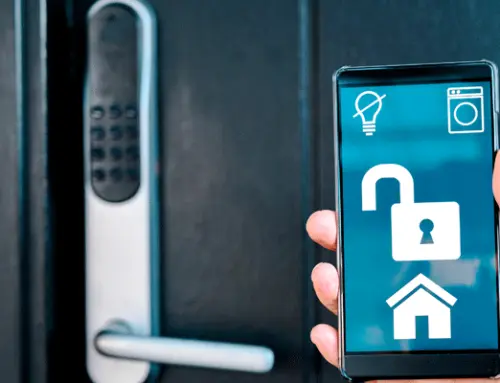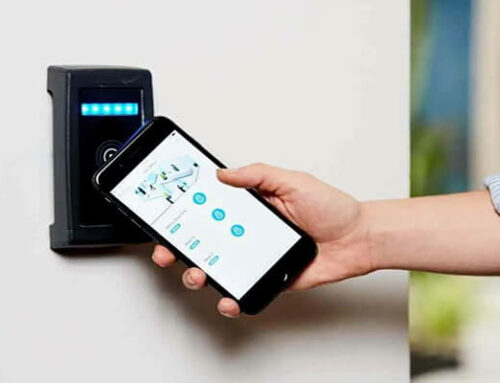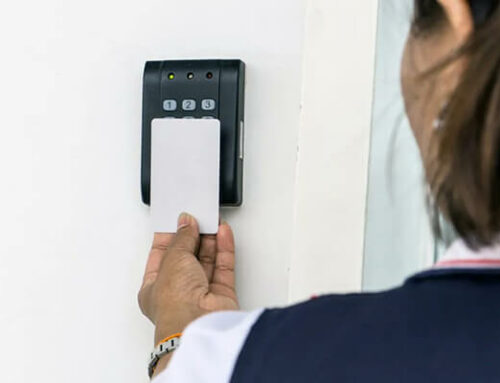Before the emergence of smart locks, people have been using traditional door locks. However, with the emergence of smart locks, more and more people choose to use smart locks to protect their homes. So, what is the difference between smart locks and traditional locks? In today’s guide, we’ll explore the differences between smart locks and traditional locks in detail. Read on to learn more.
1. What is a smart lock
The smart lock has its own system, which supports the function of the Internet of Things and is connected to the LAN and the Internet. It accepts instructions and encryption keys from authorized devices via a wireless protocol to perform locking and unlocking operations. The reason why smart locks are smart is that these locks can be connected to mobile phones. Users can monitor the opening and closing of door locks through mobile phones, combined with registration information, to know when family members go out and whether they arrive home safely. It is considered part of the smart home.
2. What is a traditional lock
Traditional locks are the earliest door locks invented and used by people. Generally speaking, the components of a traditional lock are a lock and a mechanical key. Although traditional door locks and keys look the same, each type of door lock requires a specific key to open, meaning the key matches the gears on the lock cylinder. This is the mystery of traditional door locks.
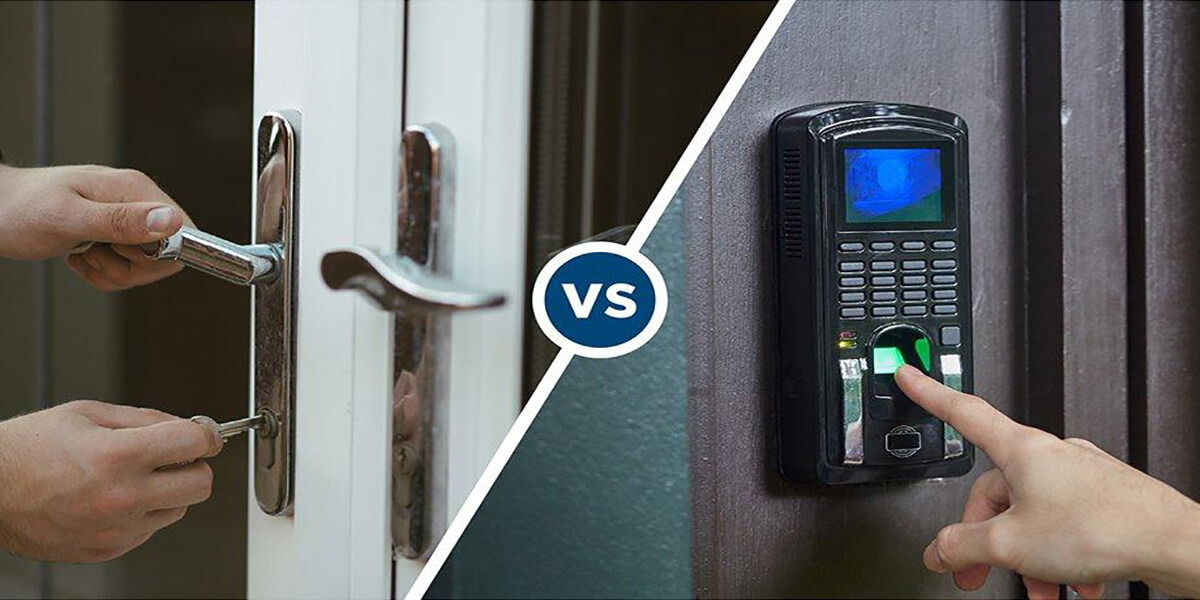
3. Smart locks vs. Traditional locks
Let’s compare the differences between smart locks and traditional locks in detail.
1) Smart locks vs. Traditional locks: Working principle
First, compare the working principles of smart locks and traditional locks.
#1. How smart locks work
A smart lock is a comprehensive product that combines integrated circuit design, electronic technology, and a large number of electronic components with a variety of innovative identification technologies, including the mechanical design of the lock body, built-in software card, computer network technology, and network alarm. In fact, the basic structure of the smart lock is to use the motor to drive the mechanical lock cylinder to complete the original manual turning of the key.
That is to say, the smart lock does not need to manually turn the key to open the door lock but uses technology to unlock the door lock. Generally speaking, a smart lock is to control the door lock by using a bridge to connect the door lock to your smartphone. This bridge can be Bluetooth, also can be a wireless network, etc.
In turn, smart door locks can also send notifications and alerts to your phone so you can always know the status of your door lock. All in all, the main operation of smart locks depends on technology. This is the main difference between smart locks and traditional locks in terms of working principles.
#2. How traditional locks work
The traditional lock is non-intelligent, it needs to unlock the door lock by turning the key manually. These locks include deadbolts, knob locks, mortise locks, tumbler locks, etc., with tumbler locks being the most commonly used. Take the tumbler lock as an example. The locking mechanism of the tumbler lock has a series of spring pins, which are loaded into the lock cylinder in turn. Cylinders consist of a set of pins designated as key and drive pins. When the correct key is inserted into the locking mechanism, the key pin is raised, which pushes the drive pin upward.
When the user inserts the correct key into the lock cylinder, the drive pin and key pin align at the shear line. Turn the key to unlock the door. If the wrong key is used, the misalignment of the pin will prevent the key from turning because the pin will bind at the shear line.
2) Smart locks vs. Traditional locks: Unlocking method
Then compare the unlocking methods of smart locks and traditional locks.
#1. How to unlock the smart lock
When it comes to the unlocking methods of smart locks, they must be diverse. The mainstream mid-to-high-end smart lock products have as many as six unlocking methods: fingerprint, password, card swiping, facial recognition, mobile phone, key unlocking, etc.
- Fingerprint unlocking: At present, fingerprint unlocking is the most common in people’s daily lives. Because it is very convenient, you only need to use your finger to open the door lock. Even children and the elderly can easily use it.
- Password unlocking: Password unlocking is to unlock the door by entering the correct and unique access code on the keypad of the smart lock. There are two types of keyboards: a key keyboard and a touch keyboard. Although they are different in form, their main function is to input passwords. This can be set when you install the door lock.
- Swipe card to unlock: Swipe card to unlock is generally used in hotels or apartments, such as RFID hotel lock. The manufacturer transmits the access code to a plastic card that the user can recognize by holding the card up to a reader.
- Face recognition unlocking: Face recognition is the mainstream technology in current smart locks. A 3D camera is used to build a 3D face model of the user, and through liveness detection and face recognition algorithms, the features of the face are detected and tracked, and integrated with the smart lock. The stored 3D face information is compared and verified to unlock.
- Mobile phone unlocking: Mobile phone unlocking is pairing with the smart door lock through the network or Bluetooth, passing the verification connection, and downloading the corresponding APP on the mobile phone, so that the door can be opened with the mobile phone, and the door lock can be remotely controlled to unlock through the temporary password.
- Key unlocking: Although the main unlocking method of smart locks is through technology, sometimes technology will inevitably fail. Therefore, while smart locks mainly use technology to unlock, they also retain the key unlocking of traditional door locks.
Of course, there are many other unlocking methods for smart locks, and the above are some common unlocking methods.
#2. How to unlock traditional locks
Compared with smart locks, the unlocking method of traditional locks is relatively simple. It unlocks the door by turning a key, turning a thumb, or pressing a button, but either way, you’ll need to do it manually. A key can only unlock one door lock, but the key can be copied infinitely. This means that if your key is copied or lost, even a stranger can unlock your door.
3) Smart locks vs. Traditional locks: Function
Second, let’s take a look at the functional differences between smart locks and traditional locks.
#1. The function of Smart Lock
Today, with such advanced technology, the functions of smart locks are not only unlocking and locking but also many other functions. Includes remote control, smart home compatibility, temporary access codes, alarm function, low battery reminder, touch sensing, voice control, fake codes, and more. These functions not only bring higher security to the house but also allow users to enjoy a smarter life.
- Remote control: This function is connected to the Internet, and the door lock can be controlled by a mobile phone anywhere in the world. Especially when you are not at home, your family and friends visit, and you can unlock the door for them through the remote control function.
- Smart home compatibility: Smart home compatibility is to combine the door lock system with your other furniture systems to achieve one-button control.
- Temporary access code: Smart door locks can assign multiple temporary access codes to other users at the same time, unlike traditional door locks that can only be opened with a specific key. Moreover, the temporary access code will expire after a specific time, thereby ensuring the security of the house.
- Alarm function: The smart lock has a built-in tamper-resistant sensor module. Once the lock is detected, the high-decibel warning alarm will sound for a long time. In case of abnormal opening and external violent damage, or the door lock slightly deviates from the door, a strong alarm sound can attract the attention of people around and effectively prevent illegal acts of thieves.
- Low battery reminder: Smart locks need to rely on electricity to maintain operation, while traditional locks will always run as long as the hardware is not damaged. Therefore, ensuring the power of the smart lock is the most important. But don’t worry, the smart lock’s built-in alarm system will remind you to replace the battery when the battery is too low.
- Touch Sensitive: Some smart locks use a sensitive screen that allows you to place a sensitive touch on the door lock.
- Voice control: Voice control is the greatest manifestation of the intelligence of smart locks. You can control the door locks through voice commands, which is never possible with traditional locks.
- False password: False password can input any number before and after the door-opening password, increase the length of the password, and eliminate the possibility of the door-opening password being leaked by peeping.
#2. The function of traditional lock
Originally, the traditional lock was invented because of the need to lock the door lock. Therefore, the most important function of traditional locks is to lock and unlock the door. Therefore, compared with smart locks, traditional locks have very single functions. But it’s perfect for seniors and anyone looking for an affordable door lock with simple features.
4) Smart locks vs. Traditional locks: Security
Next, let’s take a look at the security comparison between them.
#1. Smart Lock Security
In addition to the risk of being picked, the risk of smart locks also has the risk of hacking, which is something that traditional locks never need to worry about. These cyber-attacks can be carried out by directly accessing the lock or accessing the network where the lock resides. It puts personal data, confidential information, and other important aspects of one’s life at risk. If a smart lock is compromised, it often puts your entire home security network at risk.
But there are steps you can take to make it harder for thieves or criminals to break into your smart locks and smart devices. This usually means you have to invest in new equipment to enhance the security of your smart lock. These include investing in a high-security firewall for your home network and making sure your network passwords and access codes are changed regularly.
However, compared with traditional locks, the security of smart locks has been significantly improved. The built-in alarm function of the smart lock will send an alarm to remind you when the door lock is picked, and when special circumstances occur, the door lock will also automatically alarm. For example, an earthquake or a house on fire. Smart locks will do their best to keep you safe.
#2. The security of traditional locks
Anti-picking is the most important measure to ensure the safety of traditional locks. Anyone with the ability to search online and a little know-how can pick most traditional locks. But if installed correctly, it can make traditional locks harder to pick. In addition to picking locks, those trying to break in often use brute force to break the locks. This can be done with the right tools or even just kicking the door. Installing a crash plate can make it more difficult to brute force your front door.
Some latches are safer than others. They may receive a Class 1 ANSI rating. This rating means they offer the highest level of security. Even with the most secure traditional locks, it is often necessary to add a deadbolt plate or longer deadbolt travel to make it more secure. Also look for locks that are resistant to banging, picking, and other methods of bypassing the lock. While traditional locks can be made to be very secure, they may not be as secure as smart locks.
5) Smart locks vs. Traditional locks: Cost
Finally, let’s compare the cost difference between smart locks and traditional locks.
#1. The cost of smart locks
As we all know, smart locks cost more than traditional locks. This is different from the quality, function, and installation of the door lock. The more well-known smart locks on the market are August and Yale, and their basic packages cost about £250-£300. In addition to the purchase cost of smart locks being more expensive than traditional locks, the installation and maintenance costs are also more expensive than traditional locks. Because smart locks mainly rely on technical work, installation, and maintenance require professional personnel. Of course, if you are good enough, you can also install it yourself according to the instruction manual.
#2. The cost of traditional locks
It is undeniable that the cost of traditional locks is indeed lower than that of smart locks. For example, the cost of a new lock varies depending on the door you own. For the most basic locks, replacement cylinders for uPVC doors start at £25. This price will change if you have wooden doors, as you may need to replace the Yale or mortice locks. With Yale locks you can just replace the cylinder, Prices start at £15 or more, but if you need to replace the entire lock and door lock, prices start at £35. When replacing a mortice lock, you will need to decide if you want 3 bars or 5 bars (5 bars are usually used for exterior doors and 3 bars for interior doors). 5 leverage starts at around £45 and 3 leverage starts at £25.
To sum up, the price of traditional locks is much lower than that of smart locks.
4. Which door lock should I buy?
When you’re not sure whether you should buy a smart lock or a traditional lock, consider the following factors:
- Installation place and security: Think about where you want to use the door lock. If you want to install a door lock on the front door, it is recommended that you consider a smart lock. If you just want to lock your utility room, consider traditional door locks.
- Budget cost: If your budget is sufficient, we recommend that you consider buying a smart lock. But if you’re on a smaller budget, consider buying a traditional lock.
- Personal preferences and lifestyle: As with most home choices, your preferences and lifestyle play a large role in this decision. If you struggle with technology and are afraid of remembering your combination, a traditional lock is probably your safest bet. On the other hand, if you’re into technology and have trouble remembering physical keys, a smart lock system might be just what you need.
In fact, no matter what kind of lock, finding the lock that suits you is the most important thing.
5. Conclusion
This article compares the differences between smart locks and traditional locks from five aspects. No lock is 100% unbreakable, so choosing the lock you like is the most important thing. I hope that by reading this article, you can understand the difference between smart locks and traditional locks and find the door lock that suits you. If you have further questions, please contact iLockey.

